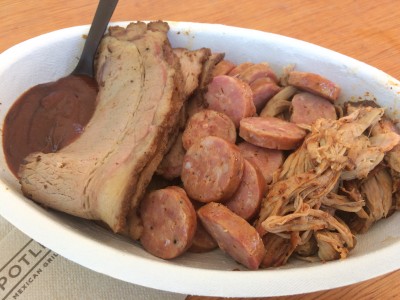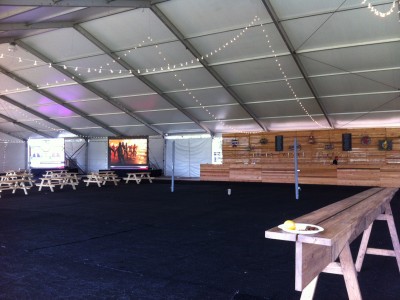Art, Food & Beverage Guide
The Art, Food, and Beverage side of any event, especially a music festival, is becoming more and more of a focus every year. It is now standard for most festivals to have food offerings a cut or two above your typical state fair / turkey legs type vendors, and often 4 and 5 star restaurants are getting into the action, allowing your guests to have a greater breadth of choice than ever before.
Art and Craft vendors are now not just sunglasses, clothing, and hats – there are festivals out there that involve vendors who sell exquisite pieces of art, sculptures, handmade goods, and other unique, quality items.
The same goes for drinks – some of the biggest hits in recent years have been the introduction of beer gardens, with a focus on craft beer. This allows the festival to charge a bit more than they normally would, and it provides the guest with more options. Craft beer gardens have been known to includes big screen LED panels with local sports, air conditioning, special tastings and flights, and a lounge atmosphere.
Below you will find a general list of what you’ll need to do in order to acquire and execute a solid roster of food, art, and beverage vendors.
- Sourcing art / food vendors
- Sourcing a bar company
- Ensuring that the bar company can:
- Serve the drinks you want (has the proper relationships with distributors)
- Provide the proper amount of liquor liability insurance coverage
- Provide you with certified bar staff
- Handle bar operations as turnkey as possible
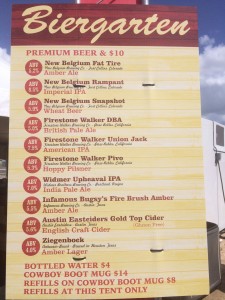
An example of beer and soft drink offerings at an event
- Ensuring that the bar company can:
- Determining the proper amount of vendors to have – entree, snack, soft drink
- The general rule of thumb is 2 entree vendors to ever 1 snack and 1 soft drink / dessert vendor, but this can vary based on the expected weather conditions and demographics of the attendees.
- Consideration as to how much duplication you should have is important; you do not want to have 4 pizza vendors and nothing else, for example.
- One example of food vendor layout / signage style:
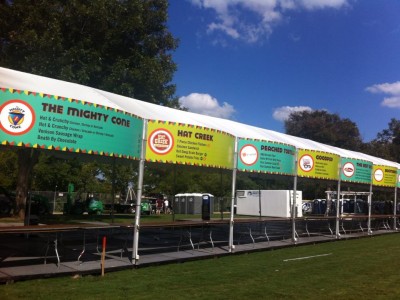
Part of the Austin City Limits Music Festival Food Court, 2013
- Determining the proper amount of bars to have
- Determining whether or not a beer/wine or mixed use (hard liqour) permit should be acquired
- Factors to weigh here are costs of the permit, costs of related insurance, what type of event are you producing (what would the crowd normally drink), and any legal issues in serving certain types of alcohol in the venue / city / state you are in.
- Creating a site layout for all bars / vendor booths that takes into account distance to/from stage, port-o-lets, gates, shade tents
- Here’s an example of how Coachella has laid out their food and beverage locations that take into account normal attendee traffic patterns (i.e., moving in between stages, using the restrooms, etc) to maximize exposure for all vendors.
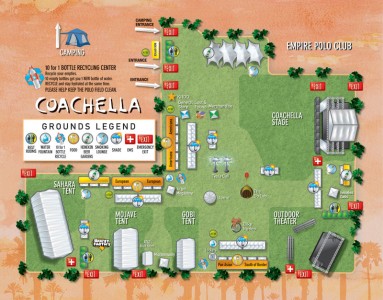
- Here’s an example of how Coachella has laid out their food and beverage locations that take into account normal attendee traffic patterns (i.e., moving in between stages, using the restrooms, etc) to maximize exposure for all vendors.
- Determining pricing for each item based on what the local market will bear, the festival’s own goals / ethos, and other factors
- Also take into account if you plan on offering free potable water
- A comparison of pricing for various events and festivals:
- Beer: Many festivals will price this anywhere from $6 – $10, with arenas and stadiums going up as high as $14. Ideally you want to keep this fair, and the going rate seems to be $6 for domestic, $8 for craft at most festivals.
- Water: $2 seems to be the norm, but many events will advertise $1 water but have smaller bottles. Anything more than $4, especially if it’s less than 20oz, is too much. It’s also a good idea to have a free potable water source for people to fill up their own containers.
- Soft Drinks: $3 for a 20oz soda is pretty standard, although some will sell supersized drinks for $4-$5.
- Wine: normally in line with domestic beer pricing, with perhaps a premium option for $8 – $10.
- Food: if possible, for entrees you want these to be just a couple dollars more than what they would pay in the “outside world”, so charging $10 for a slice of pizza is too much. Offering more intricate fare (for example, a venison burger) will allow you to charge more but still have a good perceived value.
- Dessert / Snacks: Try to keep these under $8, or a bit less than your normal range of pricing for entrees.
- Hiring a food / art vendor manager and fleshing out what their team will be responsible for
- Based on the size of the event, you may need to hire a separate food vendor manager and art vendor manager
- Putting together a plan for load-in / staging / load-out for all vendors that coordinates with other departments using the same parking lots / roads (i.e., Site Operations, Production)
- Hiring a team that oversees load-in / out, helps oversee the vendors during run of show, and checks on potential red flags like length of time to stand in line, running out of food early, or not having enough points of sale
- Ensuring there are greywater / grease traps available for food vendors
- If your event offers greywater and/or grease trap collection, need to ensure it is properly stored and removed by a certified third party vendor. Otherwise vendors will need to dispose of it themselves and may need to be supervised that they don’t pour it down unauthorized tanks (i.e. a portalet).
- Finalizing run of show needs for all
- Making a master plan for all vendor needs, including:
- Credentials
- Parking
- Power
- Plywood / Flooring
- Ice
- Making a master plan for all vendor needs, including:
- Having a plan for running out of food / beverages, line control / length, and a backup if the electronic points of sale go down
- If it is the festival policy that lines can’t exceed a certain length of time, or that all food vendors need to be open until the festival is closed for the day, the team will need to enforce these policies. Normally, vendors that break these rules are not asked back in subsequent years.
- If an electronic point of sale goes down, be it from a loss of power or internet, a backup plan on taking orders via cash only or by utilizing cellular networks to process credit cards should be in place.
- Determining the payment structure for vendors (percentage of sales or flat fee or a mix of both)
- Some events employ a flat fee for all vendors; they get to keep all profits they make. Other events employ a percentage system, where they will take a cut of all profits made. Still others will have a hybrid system with a smaller upfront fee and a smaller cut on the backend.
- Events that utilize a food ticket system (where the guest trades in cash for food tickets, then redeems those tickets at the vendor) will often use scales to weigh the tickets and determine how much each vendor owes the festival.
- Note that there are tricks vendors have used to make the weight appear different than it should be, so they can pay out less money. Show a list of these tricks.
- Creating a load-in / run of show / load-out schedule for all
- Care should be taken to stagger load-in, especially if there is not enough room for all vendors to be next to their booths at the same time. This also helps the team better manage each vendor (they aren’t spread too thin).
- All vendor should know exactly when doors are each day, and when they need to be show-ready.
- During load-out, vendors will need to know when they can bring their vehicles in. Some events may also require an audit of their space (to make sure they left it as they found it)
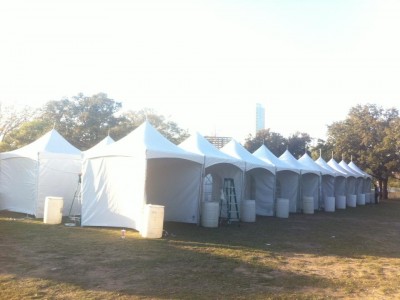 An example of an art vendor layout with 10×10 tents in multiple rows
An example of an art vendor layout with 10×10 tents in multiple rows
- Post event related accounting
- Working to clear out all expendable expenses (i.e., ice, tape)
- Settling with vendors if there is a backend system in place
- Finalizing hours worked for the team and getting everyone paid



